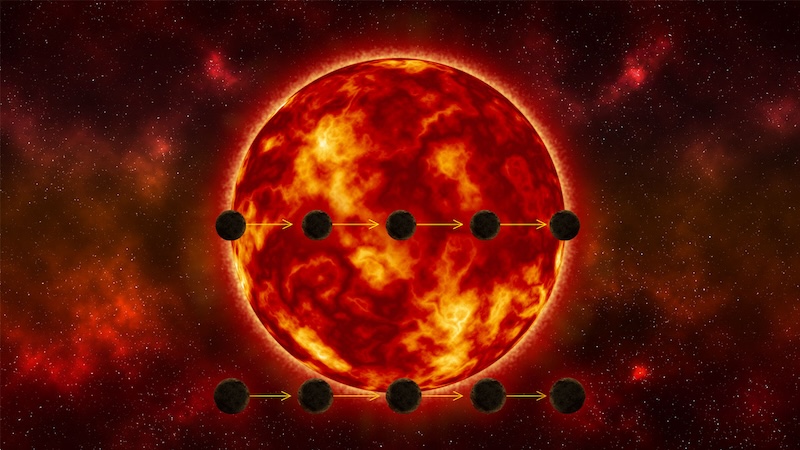
Astronomers have been discovering an ever-growing number of rocky exoplanets orbiting distant stars. Some are similar in size to Earth. And some might even be habitable. Unfortunately, that doesn’t seem to be the case with LTT 1445Ac, only 22 light-years away. The Hubble Space Telescope has now obtained the most accurate measurement yet of its diameter. And a team of researchers said last on November 16, 2023, it’s almost an exact twin to Earth in size.
But size is where the similarity ends.
Exoplanet LTT 1445Ac’s closeness to its red dwarf star means its surface is boiling! Surface temperatures hover around 500 degrees Fahrenheit (260 degrees Celsius).
The researchers first published their peer-reviewed results in The Astronomical Journal on September 25, 2023.
The 2024 lunar calendars are here! Best Christmas gifts in the universe! Check ’em out here.
Meet exoplanet LTT 1445Ac
NASA’s Transiting Exoplanet Survey Satellite (TESS) first discovered LTT 1445Ac in 2022. The red dwarf star it orbits is the most common type of star in our galaxy. And, as stated above, it lies only 22 light-years away, in the direction of our constellation Eridanus the River.
This star, LTT 1445A, is one member of a three-star system. The other two stars are closer together and lie about three billion miles (five billion km) away from LTT 1445A. There are also two other known planets in the system, both larger than LTT 1445Ac.
A transiting world
The exoplanet – LTT 1445Ac – transits or passes in front of its star, as seen from Earth. Transiting helps telescopes like Hubble to be able to measure the planet’s size and look for evidence of an atmosphere.
But there’s a rub. As seen from our world, if a distant planet transits across only a small part of a star’s disk, astronomers say it’s a grazing transit. And, in that case, it’s harder to get accurate measurements on the planet. For example, a grazing transit can result in an inaccurate measurement of the lower limit of a planet’s diameter.
And that’s what has made measurements of the size of exoplanet LTT 1445Ac so difficult. Astronomers knew this distant world transited its star, as seen from Earth. But TESS didn’t have quite enough optical resolution – it couldn’t see clearly enough – to determine if the transit was a full one or a grazing one. The paper on this subject, published in September 2023, said:
Previous studies of the exoplanet LTT 1445Ac concluded that the light curve from the Transiting Exoplanet Survey Satellite (TESS) was consistent with both grazing and nongrazing geometries. As a result, the radius and hence density of the planet remained unknown.
Although TESS couldn’t measure the planet’s diameter, Hubble could. First, the observations showed that the planet does indeed make a full transit in front of its star, not just a grazing transit. This helped Hubble obtain an accurate measurement of the planet’s size. And that’s how we know the planet is 1.07 times Earth’s diameter. Lead author Emily Pass of the Harvard-Smithsonian Center for Astrophysics in Cambridge, Massachusetts, said:
There was a chance that this system has an unlucky geometry. And, if that’s the case, we wouldn’t measure the right size. But with Hubble’s capabilities we nailed its diameter.
Not very Earth-like exoplanet
So LTT 1445Ac is almost the same size as Earth. That means it also has similar surface gravity to Earth. But LTT 1445Ac isn’t very Earth-like, otherwise. Even though its star is smaller and dimmer than our sun, the planet orbits closely enough that its surface temperature is much hotter than on Earth. Its surface temperature is a sizzling 500 degrees F (260 degrees C). That’s the same temperature as inside a pizza oven.
So LTT 1445Ac is unlikely to be habitable.

Transiting exoplanets and further observations
Astronomers like transiting exoplanets, since it allows telescopes like TESS and Hubble to detect their atmospheres, if they have them. As Pass noted:
Transiting planets are exciting since we can characterize their atmospheres with spectroscopy, not only with Hubble but also with the James Webb Space Telescope. Our measurement is important because it tells us that this is likely a very nearby terrestrial planet. We are looking forward to follow-on observations that will allow us to better understand the diversity of planets around other stars.
Indeed, astronomers will also be studying LTT 1445Ac further, to analyze its atmosphere, if it has one. The paper says:
As the nearest terrestrial exoplanet to transit an M [red] dwarf (alongside LTT 1445 Ab), this planet is an exciting target for atmospheric characterization, particularly now that it is known to be nongrazing and its radius is therefore appropriately constrained.
Bottom line: Astronomers using the Hubble Space Telescope measured the exact diameter of a nearby Earth-sized exoplanet. The sizzling world is too hot for life, however.
Read more: Are the TRAPPIST-1 exoplanets habitable, or not?
Read more: 2 possibly Earth-like worlds, just 16 light-years away











